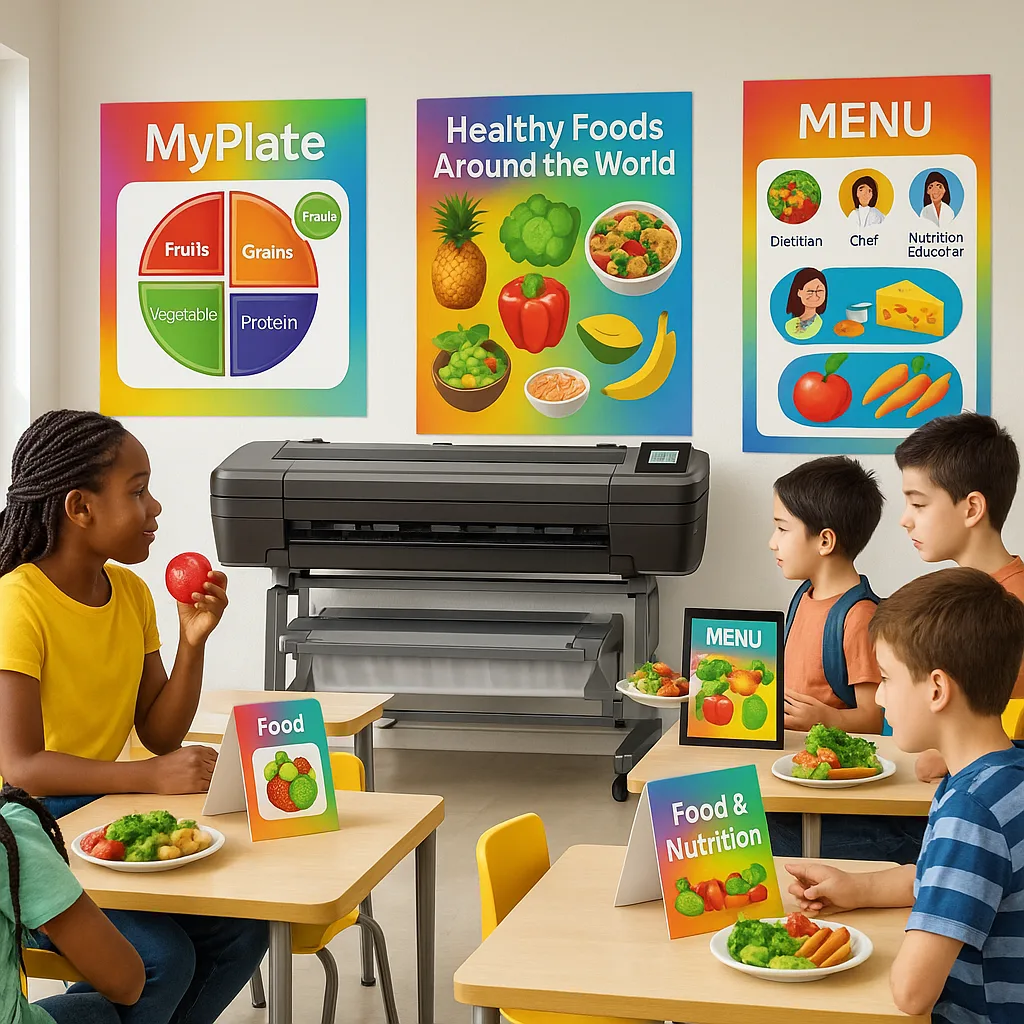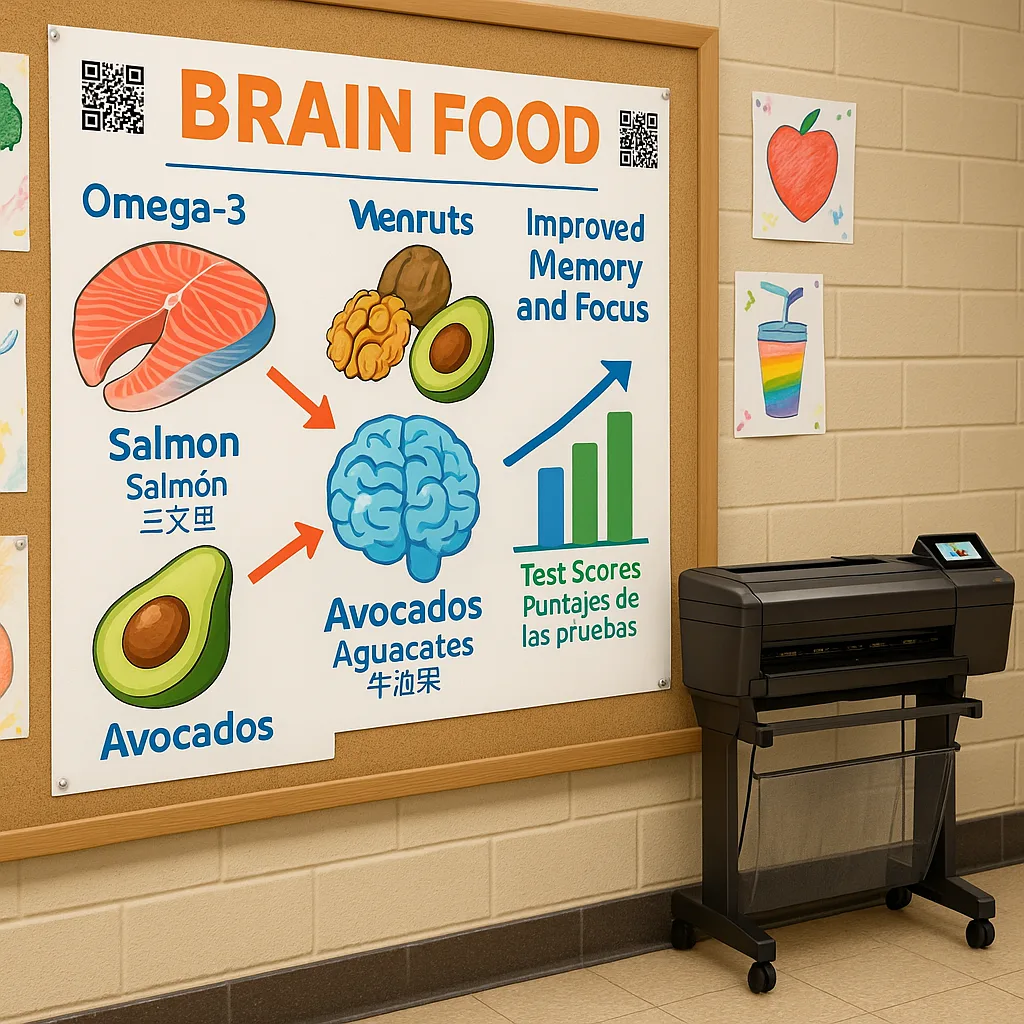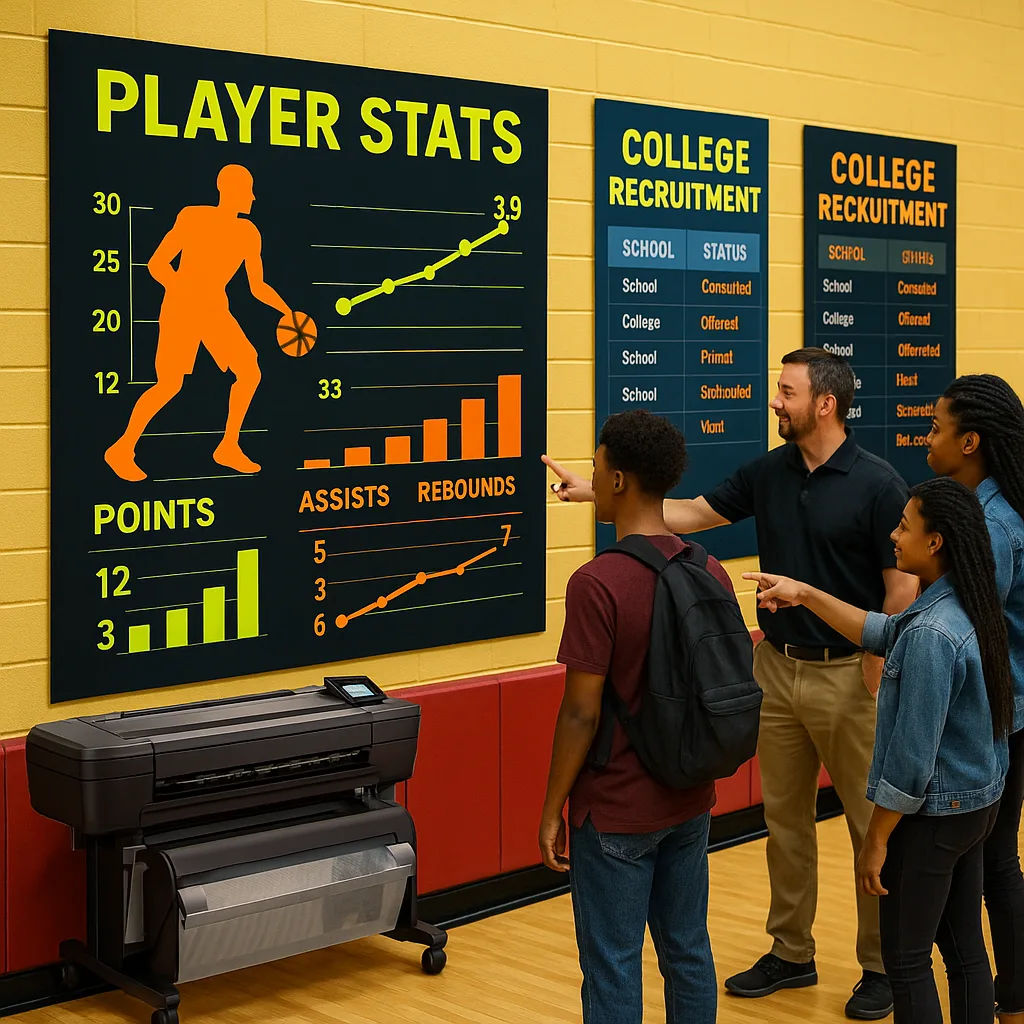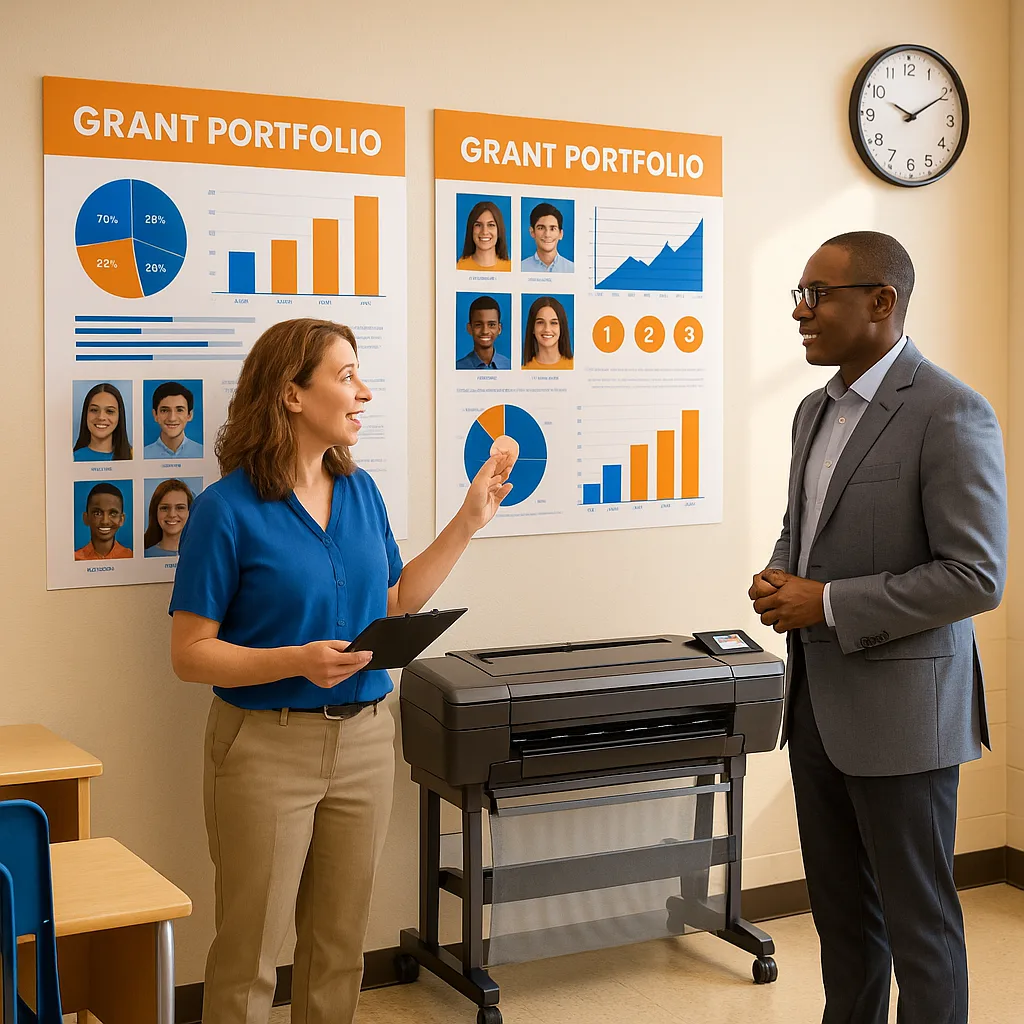
Visual Nutrition Education Transforms School Cafeterias
California schools are discovering that strategic visual displays can fundamentally transform how students approach nutrition, creating pathways from healthy cafeteria choices to enhanced academic performance and career readiness. By implementing comprehensive classroom poster maker nutrition education programs, districts report remarkable increases in healthy food consumption while building essential life skills.
Classroom Poster Maker Nutrition Education: Data-Driven Impact
Recent implementation studies across 47 California districts reveal the measurable power of visual nutrition education. Schools utilizing systematic poster campaigns report a 40% increase in fruit and vegetable consumption within the first semester. Furthermore, these visual interventions correlate with improved attendance rates and standardized test scores, particularly in Title I schools where nutrition access directly impacts learning readiness.
The California Department of Education’s latest nutrition framework emphasizes visual literacy as a core component of comprehensive wellness education. Districts investing in Education Express 24″ Poster Maker Package A create dynamic, culturally responsive displays that resonate with diverse student populations while meeting state nutrition education mandates.
Framework Alignment: Connecting Classroom Poster Maker Nutrition Education to Standards
California’s Health Education Content Standards require students to analyze influences on healthy behaviors, demonstrate interpersonal communication skills, and practice health-enhancing behaviors. Visual displays created through school poster makers address all three domains simultaneously:
- Essential Concepts (Standard 1): Large-format nutrition facts posters help students understand macronutrients, portion sizes, and dietary guidelines at developmentally appropriate levels.
- Analyzing Influences (Standard 2): Cultural food tradition displays celebrate diversity while promoting healthy choices within various cuisines.
- Accessing Valid Information (Standard 3): QR-code enhanced posters link to reliable nutrition resources and interactive meal planning tools.
- Decision Making (Standard 5): Visual decision trees guide students through healthy choice scenarios in real-time cafeteria settings.
Implementation Strategies That Drive Results
Successful nutrition education programs leverage visual displays strategically throughout the school environment. The most effective implementations coordinate cafeteria displays with classroom instruction, creating reinforcing messages across multiple touchpoints.
Cafeteria Transformation Zones
Leading districts organize cafeteria spaces into distinct visual zones, each serving specific educational purposes:
Entry Zone: Welcome displays featuring diverse students enjoying healthy meals, printed on Coated Poster Paper for durability in high-traffic areas. These 36″ x 48″ posters establish positive associations before students enter the serving area.
Menu Education Zone: Daily menu boards enhanced with nutritional information graphics help students make informed choices. Schools using poster maker machines update these displays weekly, incorporating student artwork and seasonal themes to maintain engagement.
Choice Point Displays: Strategic placement of nutrition facts at serving stations influences real-time decisions. Visual cues highlighting calcium-rich options near the milk cooler or fiber content near the salad bar demonstrate immediate practical application.
Social Learning Zone: Table tent displays and wall murals in eating areas reinforce healthy habits through peer modeling and positive messaging. These materials often feature student athletes and academic achievers discussing their nutrition choices.
Culturally Responsive Visual Design
California’s diverse student population demands nutrition education that honors cultural food traditions while promoting wellness. Effective visual campaigns balance universal health messages with culturally specific content that resonates with local communities.
Schools achieving the highest engagement rates involve parent advisory committees in poster design sessions. Using design software included with poster maker packages, committees create bilingual displays celebrating traditional healthy dishes from various cultures. A San Diego elementary school increased participation in their fresh fruit program by 67% after implementing parent-designed posters featuring families enjoying culturally diverse healthy snacks.
Template Development for Inclusive Messaging
Successful programs develop template libraries addressing common nutrition education needs while allowing customization for local contexts:
Universal Templates:
- MyPlate adaptations showing portion sizes with culturally relevant foods
- Hydration tracking charts incorporating multiple languages
- Seasonal produce calendars highlighting locally available options
- Career connection posters linking nutrition to various professions
Customizable Elements:
- Food photography featuring dishes from school community cuisines
- Student success stories in home languages
- Local farm partnership highlights
- Community health statistics relevant to specific populations
Academic Performance Connections
Visual displays explicitly connecting nutrition to academic success prove particularly effective in middle and high school settings. Districts report increased buy-in when posters demonstrate how proper nutrition impacts test performance, athletic achievement, and career readiness.
One innovative approach involves creating “Brain Food” campaigns that visualize the connection between specific nutrients and cognitive function. Large-format posters showing omega-3 rich foods alongside improved memory statistics help students understand immediate benefits beyond long-term health outcomes.
Career Technical Education programs enhance this connection by creating pathway-specific nutrition displays. Culinary arts students design professional kitchen safety and nutrition posters, while health sciences students develop medical nutrition therapy visuals. These authentic projects, produced on school poster makers, serve dual purposes as learning exercises and cafeteria education tools.
Measuring Impact Through Visual Data Displays
Continuous improvement requires visible progress tracking. Schools implementing comprehensive visual nutrition programs create data dashboard displays showing:
- Monthly participation rates in healthy lunch options
- Waste reduction metrics with visual comparisons
- Student health outcome improvements (aggregate, anonymized data)
- Academic performance correlations with nutrition program participation
These data visualizations, updated monthly using Education Studio 36″ Duplicator Poster Maker Package A+, create accountability while celebrating progress. Students see their collective choices making measurable differences, reinforcing positive behaviors through social proof.
Sustainability and Long-Term Success
Effective nutrition education programs require sustainable funding and implementation strategies. California schools leverage multiple funding sources to maintain visual nutrition campaigns:
Title I Allocations: Schools serving high-poverty populations allocate Title I funds for nutrition education materials, recognizing the connection between food security and academic achievement. Visual displays addressing weekend nutrition and summer meal programs prove particularly valuable in these contexts.
Farm to School Grants: California’s Farm to School program provides funding for educational materials promoting local produce consumption. Schools create seasonal poster campaigns highlighting featured local farms and their products, building community connections while promoting healthy eating.
CTE Perkins Funding: Career Technical Education programs justify poster maker purchases through authentic industry connections. Culinary, health sciences, and agricultural programs all benefit from professional-quality visual production capabilities.
Wellness Policy Implementation Funds: Districts allocate wellness policy budgets toward visual communication tools, recognizing posters as essential implementation vehicles for policy goals.
Professional Development and Capacity Building
Successful visual nutrition education requires coordinated professional development across multiple stakeholder groups. Districts investing in comprehensive training report higher program sustainability and impact.
Nutrition Services Staff Training: Food service professionals learn to create appealing menu displays and nutritional information graphics using user-friendly design software. This direct involvement increases buy-in and ensures accuracy in nutrition messaging.
Teacher Integration Workshops: Classroom teachers discover ways to incorporate cafeteria-based learning into subject area instruction. Science teachers use nutrition labels for data analysis exercises, while social studies classes explore cultural food traditions through poster projects.
Student Leadership Development: Peer education programs train student nutrition ambassadors to design and implement visual campaigns. These student-led initiatives often achieve higher engagement than adult-directed efforts.
Technology Integration for Modern Learners
Contemporary nutrition education leverages technology to extend poster impact beyond static displays. QR codes on cafeteria posters link to:
- Interactive nutrition calculators
- Recipe videos featuring cafeteria ingredients
- Virtual farm tours showing food origins
- Augmented reality experiences overlaying nutrition data on meal photos
- Student-created nutrition podcasts and video testimonials
This multimedia approach meets students where they are while maintaining the proven impact of large-format visual displays in physical spaces.
Looking Forward: Evolution of Visual Nutrition Education
As California continues leading national nutrition education initiatives, visual communication strategies will evolve to meet emerging challenges. Climate change education increasingly intersects with nutrition curriculum, requiring posters that connect sustainable food choices to environmental impact. Mental health awareness campaigns incorporate nutrition messaging, recognizing the gut-brain connection in student wellness.
Schools preparing for these evolving needs invest in flexible visual production capabilities. Whether creating emergency nutrition information during disasters or celebrating innovative student garden harvests, having in-house poster production ensures timely, relevant communication.
The transformation from traditional cafeteria spaces to dynamic nutrition education environments demonstrates the power of strategic visual communication. By implementing comprehensive poster campaigns that connect healthy eating to academic success and career readiness, California schools create lasting positive change in student lives. The 40% increase in healthy food consumption represents just the beginning – these visual education programs lay foundations for lifetime wellness practices that extend far beyond school walls.
For schools ready to transform their nutrition education programs, exploring poster maker solutions opens doors to endless creative possibilities. Lifetime Design Service support ensures that even schools without dedicated graphic design staff can create professional, impactful displays. Combined with 5 Year Next Business Day Warranties, these investments provide long-term value for comprehensive nutrition education initiatives.
The cafeteria-to-career pipeline strengthens when students see clear connections between daily choices and future opportunities. Through thoughtful visual education strategies, schools empower students with knowledge and habits that serve them throughout their lives, creating healthier communities one poster at a time.








